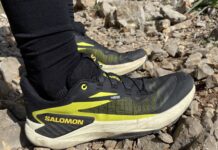
This week we take a look at Saucony’s line up of running shoes.
Founded in Pennsylvania in 1898 and relocated to Cambridge, MA in the 1960s, Saucony is one of the oldest running shoes brands.
Over the past couple of years, Saucony revamped most of their shoe designs thanks to two main innovations: the ISOFIT upper construction and from this year the EVERUN sole material.
Saucony classifies their shoes in a very traditional way based on Pronation support, Road vs Trail and Racing/Track shoes.
Within each of these categories live different shoes for different runners. We are going to break the line down to make it easy to understand, but not before giving you a quick overview of Saucony’s main technologies.
ISOFIT
ISOFIT is the relatively new upper construction that Saucony places on all their higher-end models.
It is such a drastic change according to Saucony that once a model gets the “ISO” treatment, the numbering starts from 1. For example after the Triumph 12, there is the Triumph ISO and after that one the ISO 2.
What is ISOFIT?
(image from Saucony.com)
It’s an ultra-soft inner sleeve made of stretchable air mesh, that morphs to the foot for a sock-like feel with a floating support cage around it that cradles the foot.
There’s a little more to it. The inner mesh sleeve is actually made of 4 different kind of meshes, on the midfoot, midfoot sides, toebox, tongue…
The external support cage is where the 4 eyelets are and locks the foot securely to the shoes. The cage extends over the heel, leaving a window open.
ISOFIT is quite a substantial change to Saucony’s previous models and it commended a $20 to $30 price increase, depending on the model.
FlexFILM
FlexFILM is what Saucony calls their new overlay tech. Instead of sewing plastic pieces to the upper to provide support and structure, the overlays are now melded to the upper in order to both save weight and reduce possiblities for irritation and blisters.
Powergrid and Powergrid+
Powergrid+ is the evolution of Powergrid, which in turn is the evolution of the original Progrid technology.
In a nutshell, the “grid” system is a perforated layer between the insole of the shoe and the midsole that acts as a net. Landing your foot over a net design helps spread the shock of the impact on a wider surface.
Powergrid evolved on the Progrid system by utilizing a lighter material.
Powergrid+ differs from Powergrid in the way that instead of being a separate layer on top of the midsole, now the midsole itself incorporates the holes that create the grid system.
EVERUN
EVERUN is the newest Saucony technology and it’s slowly but surely being incorporated in all new premium Saucony running shoes.
As you can see from the image above, EVERUN is an additional layer of cushioning material that lives close to the foot, providing a more immediate cushioning. According to Saucony it provides an 83% energy return and it does not break down with usage.
Saucony Running Shoes: explaining the line
Now that we had a look at the technologies, let’s talk about shoes. As mentioned earlier – Saucony still sticks to a very traditional categorization system diving between Neutral and Support, Road and Trail. That’s the way we are going to look at them.
Saucony Neutral Running Shoes

$120 – The Ride is Saucony’s bread and butter cushioning neutral running shoe. It is an ideal entry into the world of Saucony, with a low but not too-low drop of 8mm, a nice soft cushioning that is neither too plush nor too responsive and the addition of EVERUN enhances the feeling while the foot lands on the ground. Reliable and durable, it is a perfect beginner shoe for daily training.

$110 – The Kinvara is arguably Saucony’s most successful running shoe in the past few years. Compared to the Ride, the Kinvara has a lower drop (4mm instead of 8), it’s an ounce lighter and its cushioning is much more responsive. It can be a daily trainer for faster runners or can be the racing shoe for runners of all abilities in distances from 5k all the way up to the marathon.

$100 – The Breakthru is a step between the Ride and the Kinvara. It still provides a safe 8mm drop, but it is lighter than the Ride and more durable and cushioned than the Kinvara, with a cushioning that falls in between the safe soft feeling of the Ride and the aggressive responsiveness of the Kinvara. If you are looking for a shoe that can take you from daily training to race day, the Breakthru is your shoe.

$130 – The Zealot is a highly cushioned neutral running shoe with a 4mm drop. For a small increase in price from both the Ride and the Kinvara, it features ISOFIT which is an upper construction made for comfort and personalized fit. With a 4mm drop it has a ride similar to the Kinvara but a much plusher cushion. Many runners use this shoe as their raceday shoe for half and full marathons.
Saucony Triumph ISO 2

$150 – Triumph is Suacony’s top of the line cushioning shoe. It features all technologies from ISOFIT to EVERUN, together with a 8mm heel to toe drop. You can call this the Ride’s big sister, as it provides a similar running experience but in a premium package thanks to the materials used and the incredibly plush cushioning.
Saucony Echelon 5
Saucony Support Running Shoes
Saucony Redeemer
Saucony Trail Running shoes

$110 – The Nomad TR is the entry-point for Saucony’s line of trail shoes. The heel-to-toe drop is 4mm like all the shoes in this line. We find it a very decent shoe for the amount of solutions it packs in its $110 price point, including a one-piece upper construction for endured comfort. It is a perfect first trail shoe or road-to-trail shoe.
Saucony Peregrine 6
Did you find this article useful? Please share it on your favorite social network using the buttons below – thank you!
Don’t forget to have a look at the other brand guides we wrote this year:






































